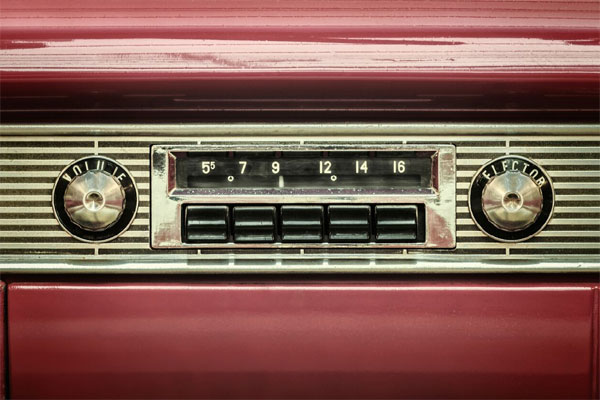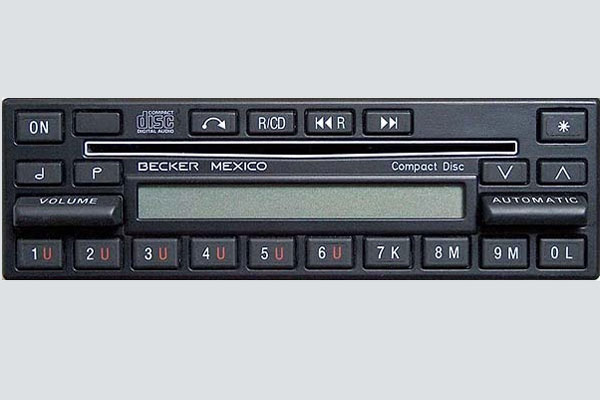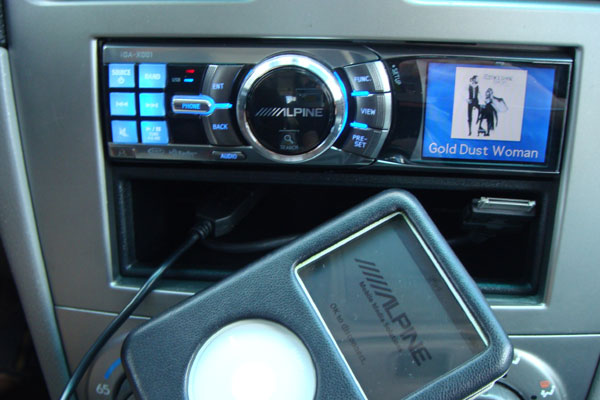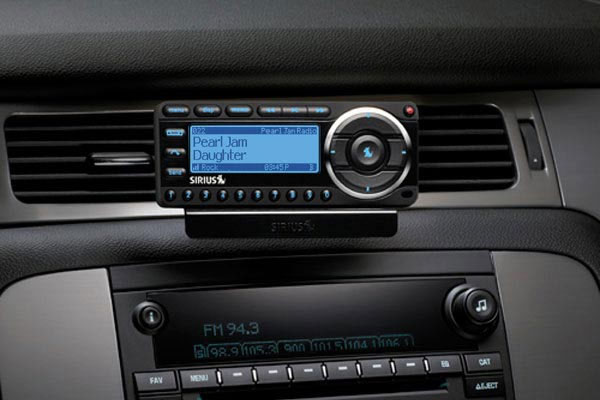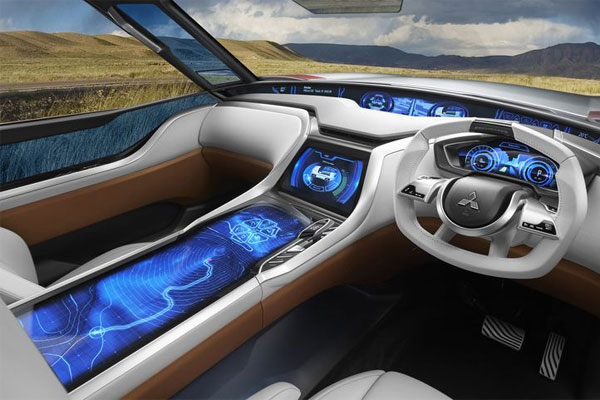by Rudolfo San Miguel
I take my car stereo for granted. It has always been part of my driving or riding life. Since I was a child, these stereos have always been there for my listening pleasure. As a driver, it kept me going during long commutes. It has distracted me, entertained me, and irritated me. When I was much younger, there was nothing more than AM/FM radio units. Later, I encountered units that include a cassette tape player, and then CD player. Now, I simply attach my IPod to my stereo to listen to my personal collection of music. I have had a long love/hate history with the car stereo, sometimes known as a “head unit.”
What is a “head unit”? A head unit is basically your car stereo; specifically it references the control system that offers your audio features available through its components. Differing from an Infotainment system, which offers more comprehensive features beyond the audio components, the head unit is still the dominant audio device in cars. Here is what Edmunds.com says about head units:
The head unit is what lets you choose the audio source, set the volume, determine the specific song you want to hear or pick the radio station you want to listen to. All audio signals also start with the head unit. It generates sound from both “over the air” signals, such as radio, and recorded formats, such as a CD and other digital media. A car head unit typically has everything but the speakers crammed into that one box in your dash…
Let me take you on a little history of head units, from simple car stereos to today’s Infotainment hubs:
1930 to 1953: The Beginnings of the Head Unit
In 1928 two brothers, Paul and Joseph Galvin, bought plans for a battery-eliminator and manufacturing equipment at an auction for $750 from the Stewart Battery Company, which went into bankruptcy. The brothers formed a company together called Galvin Manufacturing, which we know today as Motorola. This purchase allowed the brothers to develop not only the household radios, but also the first head units. The battery eliminators worked in vacuum tube radios, allowing these receivers to run on a standard home electric current or car-generated electric currents.
Galvin Manufacturing sold their head units for around $130 (today’s equivalent, adjusted for inflation, would be around $1,800). The radio offered only AM reception and this endured as the standard in car audio for around 20 years.
By the 1950’s, head units became much less expensive and a new arena had emerged in the radio market. FM radio was still evolving and hadn’t developed as a popular listening choice; however, this didn’t stop head unit manufactures to begin to develop products that offer FM reception.
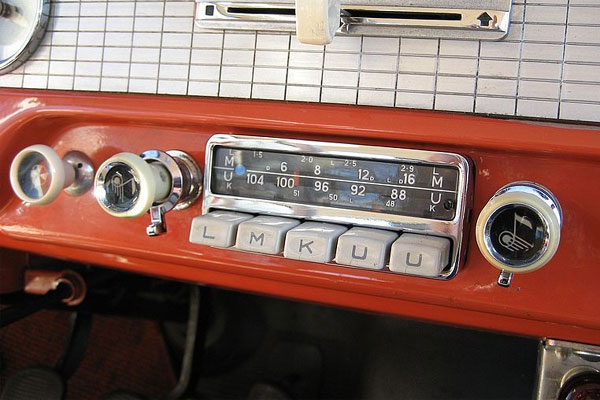
By Yeti.bigfoot – Own work, CC BY 3.0, FORD Taunus 17M P2(TL) deLuxe Two door 1958 Radio receiver BLAUPUNKT Köln
In 1952, Blaupunkt would be the first company to manufacture head units that offered both AM and FM reception. Though the units were considered a novelty, they would eventually become standard car audio equipment in cars. Blaupunkt was a German-based company that was named for the German word for “blue point” or “blue dot”, which was painted onto its headphones that had passed quality control.
1965 to 1970: The 8-Track and the Cassette Player
In September 1965, Ford Motors debuted the 8-track player as an option to be included in their 1966 car models. In the beginning, 8-track tape players existed only as accessories in car (home players were later introduced); as a result, 8-track cartridges in the beginning were sold only in auto parts stores and the similar retail businesses.

By CZmarlin – Own work, CC BY-SA 3.0, Factory installed AM/FM/8-track unit in 1978 AMC Matador with a Briefcase Full of Blues cartridge in “play” position
8-Track tapes were popular for two decades and became the alternate source of audio inside cars. They had several advantages over records, most obviously that one could realistically listen to them in their car. Here is what WiseGeek.com wrote about 8-Tracks:
Sometimes known as 8-track cartridges, 8-track tapes are a type of recording technology that along with cassettes and vinyl records served as a primary format for the distribution of recordings during the 1960s and 1970s. Considered an improvement over the reel-to-reel tapes that were common prior to 1960, 8-track tapes offered a means of using recording tape to create copies of recordings while providing the protection of a sealed plastic housing that helped to minimize the incidence of damage to the tape.
This trend didn’t last as car builders soon were to add head units that offered Cassette-Tape Players. These compact cartridges began taking over the 8-Track’s market by the mid-1970s. The first car’s to offer cassette players in their head units quickly became more popular over their 8-Track cousins. In fact, this new recording method was such an improvement over all its predecessors that it made any other method redundant, outside of use in radio stations or professional grade recording studios.
By late 1982, most retailers began to phase out 8-tracks as a consumer option and by the mid-1980’s the format was a relic of previous decades and an older generation. The cassette would become the new format for recorded audio playback in cars; however, their reign would only last for a short time as did its predecessor the 8-Track.
The 1970s also saw the beginning of aftermarket – the section of the automotive industry involved with parts and accessories after the initial sale. Stereo shops allowed car owners to customize their cars themselves, and soon became a popular option for those drivers that wanted exceptional sound quality. Companies began to sell pull-out cassette receivers and higher-quality speakers that drivers could install themselves.
1982 to 1985: Head Units reach new levels of digital innovation
In 1982, Cadillac and Bose partnered to create a new evolution in head unit sound systems. They would offer the new system in that year’s Cadillac Seville. Designing a completely new kind of head unit, Bose offered a custom engineered unit, which provided audio output specifically designed for the acoustics of the 1982 Seville.
By 1984, cassette players had a new competitor in the audio playback market. In 1984 Pioneer introduced the the world’s first car CD player, the CDX-1. Becker introduced their latest head unit called “Mexico,” which offered the first ever CD player built in their system. Compact Discs, more commonly known as a CD, contain a data storage format that is burned onto a digital optical disc, the CD itself. The format was designed for music storage and playback. The CD’s were able to offer better sound quality and the ability to instantly skip tracks. Later, the technology was modified and evolved into the CD-ROM format, which allowed for more liberal data storage that became the staple for computer and other digital data readers. This led to the creation of many other variants—CD-R, CD-RWVCD, SVCD, Photo CD, PictureCD, CD-i, and Enhanced Music CD.
Jim Russell, who worked for General Electric and the Battelle, invented the CD technology after Battelle recognized his creativity and provided him time and a laboratory to work on his ideas. Philips and Sony licensed Russell’s idea and released the first music CDs in 1982, which took off quickly. The rest is history.
1990s – complete CD takeover
Different formats of CD gained popularity and became wide-spread by the mid of 90s. Multi-disc CD changers became the popular option among the drivers, and were offered as the factory upgrades or aftermarket options. By the mid-1990s, it was common to find a CD changer in a given car’s trunk or underneath the front passenger seat.
The Digital Era of the 2000’s
As the era of handheld devices began to dawn, the rising sun of digital storage and playback would quickly shine its light across old audio playback methods. This began shortly after the creation of the iPod®, which introduced a familiar technology that offered access into current head units.
The 3.5 mm Auxiliary output port became a new gateway to the emerging power of iPods, and later Smartphones and tablets. Soon, head units would also include USB ports. This would allow these devices to access head units and integrate data offered in the devices—like track title, song duration, and much more. With the emergence of smart phones, head units would be conduits for streaming audio, further extending access to car stereo’s to online radio stations, along with global radio stations streamed through the internet.
In addition to hand-held devices, head units were also beginning to harness audio offered through satellite radio. Sirius® and XM® became the two leaders in this industry as they revolutionized radio broadcasting. Not since the introduction of FM had there has been such advancement in car radio.
Beginning in the summer of 2002, Sirius offered 69 streaming channels of music with an additional 65 streams of sports, news, and other non-music entertainment for its customers. Channels broadcasted 24 hours a day, both commercial-free and uncensored. Starting with $14.99 monthly subscription fee and $15 activation fee per radio receiver, Sirius required special satellite radio receivers; however, many car models started offering satellite radio receivers as part of the factory head units.
Another competitor was XM Radio. Formed in 1988 as the American Mobile Satellite Corporation (AMSC), which was a collective of smaller organizations; this company officially began broadcasting in the fall of 2001. They also had an online service known as XM Radio Online or XMRO. They offered many similar music streams as their satellite radio sister company and were available through a smart phones. Sirius would eventually purchase XM Radio becoming the sole dominant company in that market.
Bluetooth became the standard for hands-free phones in the car by 2010, and later more automakers added Bluetooth audio. First Bluetooth hands free car kit was introduced back in 2001.
It allows drivers to cut the cord between their stereo and other music mobile sources such as Smartphones. Car manufacturers began adding more advanced controls and features for Bluetooth audio, such as album art and track control on a car’s head unit.
Beyond 2010: An Infotainment Odyssey
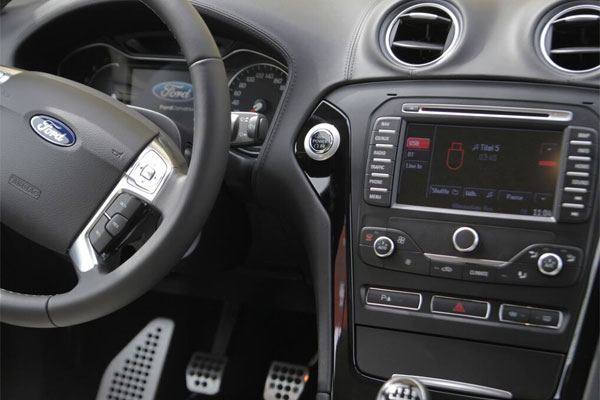
Getty Images: Ford Mondeo 2014. The shown car is from Titanium series, it contains a full leather interior, many technical and multimedia features and a 240hp turbo engine that made it the strongest and fastest Ford model available ever, up to the remake muscle car Mustang was released a year later.
As the digital revolution began to accelerate, car manufactures started to think more creatively with head units and what was possible. GPS navigation systems were rapidly evolving, along with digital music storage and replay. New car models began to offer what was to be called “In-car Entertainment Centers (ICE),” but what would more broadly become known as “Infotainment systems.”
These systems would act as both information and entertainment hubs, providing many of the features previous found in car head units along with other features: GPS navigation, rear camera view for backing, weather, internet access, music, internet radio such as Pandora and Slacker, satellite radio, USB access to USB mass storage and hand-held Smartphone devices, and much more.
In 2014 two giants, Apple and Google, began the “rush to the car infotainment” with the introduction of the CarPlay and Android Auto. CarPlay and Android Auto are basically the standard of connecting the Smartphone to the factory stereo. This standard enabled the car radio or the head unit to be a controller and display of the smartphone. The standard became available in select 2016 vehicles, and some aftermarket stereos such as Pioneer AVIC-8100NEX, Apline iLX-007, Kenwood DDX6902S, and others.
The Future beyond the head unit: Driverless cars
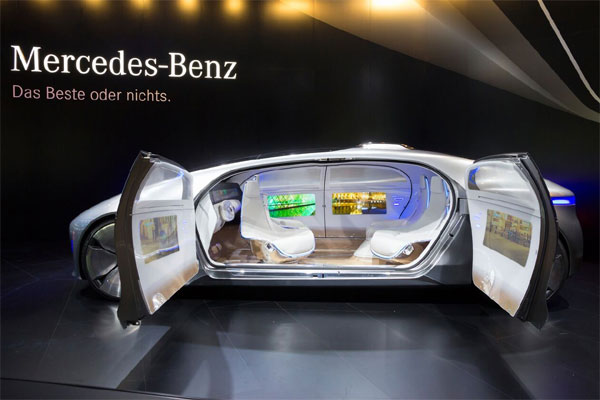
Getty Images: Frankfurt, Germany – September 16, 2015: Mercedes Benz autonomous concept car at the IAA 2015.
The current Autonomous Driving technology that is being talk about is so new that it hasn’t even arrived for customers yet. Many automakers are developing driverless cars where owners aren’t involved with driving primarily, freeing them up to focus on other situations. Whether its work or having fun, car owners may no longer have to focus on their driving at all with this future innovation in driving technology.
By using a variety of methods, these vehicles would sense their surroundings (including relevant signage) and use advanced control systems to interpret that data to choose the appropriate navigation path, while avoiding possible obstacles. Many of these proto-type vehicles utilize devices like radar, lidar, GPS, Odometry, and computer vision to collect the appropriate data.
Though companies like Google that are working hard to make driverless cars possible, the likelihood of seeing these vehicles on the street regularly are still far from reality; however, automakers are moving fast to make sure these vehicle are available as soon as possible.
“The transition to roadways filled with driverless drones will be gradual,” Ragunathan “Raj” Rajkumar, a professor of electrical and computer engineering in Carnegie Mellon University’s CyLab, said in an article in Scientific American, “People will buy cars with more and more autonomous features in the coming years until, sometime in the 2020s, the majority of vehicles on the road will for the most part be fully autonomous.”
With this being said, the driverless car concept opens a new era of in-car entertainment and infotainment options. The drivers will have endless possibilities to watch favorite movies, listen to the internet radio, work, sleep and have fun – all while being driven by their cars. It is predicted that by 2025 the self-driver cars will become commonplace. We have a nice opportunity to see how it will shape our relationship with the cars, our roads and our society as the whole .
The Timelessness of Head Units
In the end, we still have the basics in every head unit, which includes some kind of radio and playback device, whether installed in the car or attached. In a world with long commutes and occasional round trips, the value of head units has never diminished. As time passes the only thing that has changed are the features and quality of the head units available to us. They have been and are as fundamental to the driving experiences as most components in vehicles then and now.
I still own a car that primarily offers only a radio and a CD player. It does have a receiver to acquire satellite radio; however, the most advanced technology I use in this system is the Auxiliary port to access music on my iPod. The next time I buy a car, which will probably be close to a decade from now, will surely have an advanced Infotainment system. I haven’t speculated how I’d use this system. Some would say, I wouldn’t even be involved with driving this future vehicle. For now, I’m happy with what I have and don’t plan on upgrading my head unit. I still occasionally play around with the radio. But the reception isn’t always good, and I am nearly completely intolerant to commercials. This much hasn’t change since I first started playing around with car stereos when I was a kid.
About the author: Rudolfo San Miguel is the independent writer at GROM Audio
GROM Audio offers Bluetooth car kits that supply both hands free and wireless music streaming. The company’s mission is to make driving happy and safe. In addition to Bluetooth systems, GROM Audio offers advanced Smartphone integration for both Android and iPhone, making your car smart and connected. www.gromaudio.com

